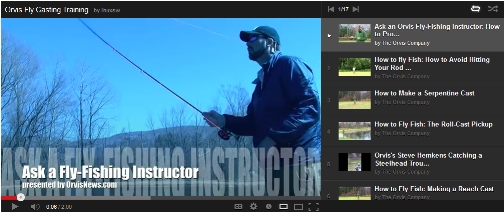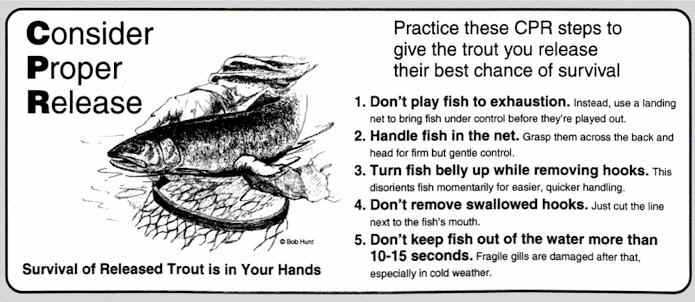With an eye toward angling success, Nutmeg TU shares with members and other anglers tips on matching the hatch.
Orvis Fly Casting Videos
Click the image above to view a list of 17 fly casting videos, courtesy of Orvis.
Major Hatches in Connecticut Streams* | ||||||||||
| NAME | Size | Mar | Apr | May | June | July | Aug | Sept | Oct | Notes |
| Caddisflies/Sedges | ||||||||||
| Winter Caddis (Dolophilodes distinctus) | 20-24 | Farmington hatch, Nov-Apr morning. | ||||||||
| Black Caddis (Brachycentrus) Other similar species: _Psilotreta: 14-16 _Glossosoma: 20-22 _Micrasema: 20-22 | 16-18 | Important hatches. Use black/dark dun fly & match size. Emergers often work best. | ||||||||
| Green C./Rock-Worm (Rhyacophila fuscula) | 14-18 | Fish imitation of larva for best results. | ||||||||
| Alder Fly/Zebra C. (Macrostemum zebratum) | 12-14 | A Housatonic staple. Fish the larva/pupa. | ||||||||
| Cinnamon/Spotted/Tan (Ceratopsyche, Hydropsyche) | 16-20 | Important. Mainly an evening hatch. | ||||||||
| Dot-Winged/Mottled (Frenesia) | 16-18 | Important. Hatches into December. | ||||||||
| NAME | Size | Mar | Apr | May | June | July | Aug | Sept | Oct | Notes |
| Mayflies | ||||||||||
| Blue-Winged Olive (BWO) (Baetis tricaudatus) | 16-20 | Important & widespread. 3 broods. | ||||||||
| Quill Gordon (Epeorus pleuralis) | 14 | Getting to be rare; needs healthy streams. | ||||||||
| Little Mahogany/Blue Quill/Paraleps (Paraleptophlebia) | 18 | Early spring hatch. Use fine tippett. | ||||||||
| Hendrickson (Ephemerella subvaria) | 12-14 | Locally rare. Best hatches: Farmington, Housatonic. | ||||||||
| March Brown/Gray Fox (Maccaffertium vicarium) | 12-14 | Not always found in local streams. | ||||||||
| Pale Evening Dun/Sulphur (Ephemerella rotunda) | 14-16 | An important hatch, peak lasts 2 weeks. | ||||||||
| Brown Drake (Ephemera simulans) | 8-12 | Housatonic: important spinner fall. | ||||||||
| (Little) Sulphur (Ephemerella dorothea) | 16-18 | An important hatch, particularly during evenings. | ||||||||
| Large BWO (Drunella cornuta) | 14 | Best 9-11 am. Medium olive dubbng. | ||||||||
| Light Cahill (Stenacron interpunctatum) | 12-14 | Dependable but not heavy hatches. | ||||||||
| Isonychia/Mahogany Dun (Isonychia bicolor) | 10-12 | Hatches are localized and sporadic. | ||||||||
| Trico (Tricorythodes stygiatus) | 22-26 | The Farmington has a great Trico hatch. | ||||||||
| Tiny BWO (Acentrella turbida) | 22-26 | Hatches afternoons when weather is worst. | ||||||||
| NAME | Size | Mar | Apr | May | June | July | Aug | Sept | Oct | Notes |
| Stoneflies | ||||||||||
| Early Black Stonefly Early Brown Stonefly (Taeniopterygidae) | 14-18 | Important late winter hatch peaks in Feb & March. | ||||||||
| Giant Black S./Stone Creeper/Salmonfly (Pteronarcys) | 6-8 | Hatches mainly at night. Use nymphs year round. | ||||||||
| Golden Stonefly (Perlidae) | 6-10 | Sporadic May-Sept. Use nymphs year round. | ||||||||
| (Little) Yellow Sally (Chloroperla, Isoperla ) | 14-18 | Seldom numerous, often overlooked. | ||||||||
| NAME | Size | Mar | Apr | May | June | July | Aug | Sept | Oct | Notes |
| (Other) | ||||||||||
| Midges/Gnats (Chironomidae) | 18-32 | Crucial; year round. | ||||||||
| Damselfly – nymph (Zygoptera) | 10-14 | Likes warmer trout streams. Fish the nymph. | ||||||||
| “Terrestrials“, i.e. anything that falls in (ants, beetles, grasshoppers, crickets, inchworms, katydids, leafhoppers, spiders.) | esp. 10-18 | Very important. At times main source of food. Match the hatch. | ||||||||
| Smaller Fish | 6-12 | Fish streamers (e.g. ‘Black Ghost’, ‘Gray Ghost’) and bucktails (e.g. ‘Mickey Finn’, ‘Black Nosed Dace’) year round but especially late fall – early spring, when waters are high and not much is hatching. Or try fishing large and/or weighted streamers such as zonkers, matukas and sculpins very early in the morning or right after a major storm when targeting large predatory trout. | ||||||||
*Amateur entomologist? Join The River’s Calendar, a community science project that aims to use recreational angler participation and innovative technology to: collect data on the phenology of stream ecosystems; increase public understanding of climate change and other environmental changes affective riparian system, and promote conservation of coldwater fisheries. ~~~ Please fish for trout only when the water temperature is ≤ 66º F – which means | ||||||||||
| ©2015 Nutmeg chapter Trout Unlimited | ||||||||||
Download the full Hatch Chart of CT Streams – 2012 (Excel)

